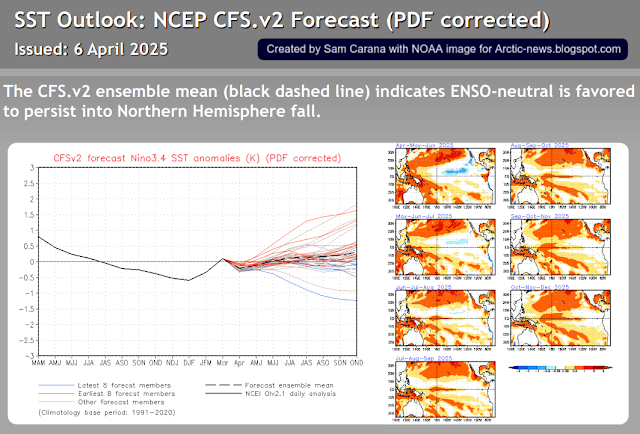The image below shows NASA data through March 2025. The monthly temperature anomaly has now been more than 1.5°C higher than the 1903-1924 custom base (not pre-industrial) for 21 consecutive months (July 2023 through March 2025). Anomalies are rising rapidly, the red line (2-year Lowess Smoothing trend) points at 2°C rise by the end of 2026.
The shading added in the above image reflects the presence of El Niño conditions that push up temperatures (pink shading), La Niña conditions that suppress temperatures (blue shading), or neutral conditions (gray shading). Meanwhile, NOAA has announced that La Niña conditions have ended, meaning that temperatures are no longer suppressed.
Such short-term variables are smoothed out in the black linear trend that shows a steady rise of 0.5°C over 3½ years (from 2023 to half 2026), a much steeper rise than the 1.1°C rise over 81 years (from 1941 to 2022) of a linear trend in an earlier image.
The steep rise in temperatures in 2023 is also reflected in ocean temperatures. The image below shows sea surface temperature anomalies through March 2025, with a very steep rise visible until August 2023 due to El Niño, followed by a fall that was only half its size, while temperature anomalies look set to rise again now that La Niña is over. The red line (two-year Lowess Smoothing) indicates a steep rise that points at a continued steep rise far beyond 2026.
The image below shows NOAA's ENSO (Nino3.4 sea surface temperature anomalies forecast) outlook issued April 6, 2025, with rising El Niño probabilities.
 |
| [ Arctic sea ice volume, click to enlarge ] |
A new El Niño may emerge soon and the red curved trend warns that the temperature rise could accelerate further, rising beyond 2°C (from 1991-2020) in the course of 2026. Such acceleration could occur not only due to El Niño but also due to feedbacks and further mechanisms such as loss of sea ice.
High ocean temperatures result in low Arctic sea ice volume, as illustrated by the image on the right and as discussed in this earlier post.
As the likeliness of a huge and accelerating temperature rise, the severity of its impact, and the ubiquity and the imminence with which it will strike all become more manifest—the more sobering it is to realize that a mere 3°C rise may suffice to cause human extinction.
 |
| [ from earlier post ] |
Climate Emergency Declaration
The situation is dire and the precautionary principle calls for rapid, comprehensive and effective action to reduce the damage and to improve the situation, as described in this 2022 post, where needed in combination with a Climate Emergency Declaration, as discussed at this group.
Links
• NASA - temperature anomalies
https://data.giss.nasa.gov
• Climate Reanalyzer
https://climatereanalyzer.org
• Copernicus
https://climate.copernicus.eu
• NOAA - ENSO: Recent Evolution, Current Status and Predictions - issued April 7, 2025
https://www.cpc.ncep.noaa.gov/products/analysis_monitoring/lanina/enso_evolution-status-fcsts-web.pdf
• Climate Reanalyzer
https://climatereanalyzer.org
• Copernicus
https://climate.copernicus.eu
• NOAA - ENSO: Recent Evolution, Current Status and Predictions - issued April 7, 2025
https://www.cpc.ncep.noaa.gov/products/analysis_monitoring/lanina/enso_evolution-status-fcsts-web.pdf
https://ocean.dmi.dk/arctic/icethickness/thk.uk.php
https://arctic-news.blogspot.com/2022/10/transforming-society.html
• Climate Plan
https://arctic-news.blogspot.com/p/climateplan.html
• Climate Emergency Declaration
https://arctic-news.blogspot.com/p/climate-emergency-declaration.html






